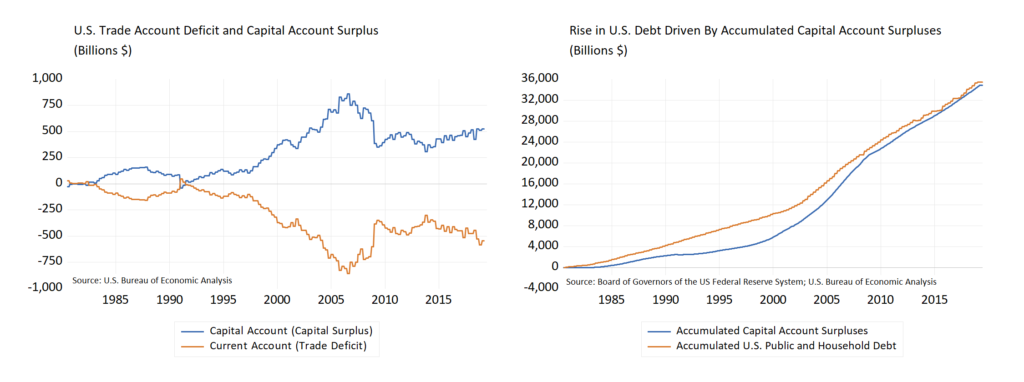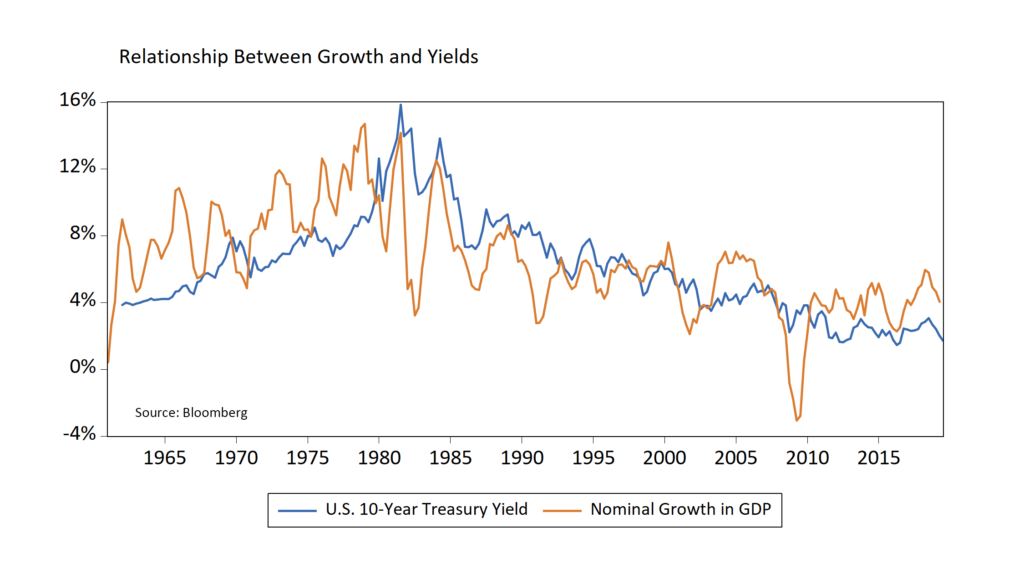Emerging Portfolio Themes
In the past couple of months, a number of headlines have caught our attention. We are reminded that corporate debt is surging, interest rates are at very low levels, and a trade war is ongoing. This week we look at specific portfolio actions that can be taken to weather the storm.
Recent Headlines:
“Volume of New Corporate Bond Issuance Breaks Weekly Record” — Bloomberg (September 9, 2019)
“In Bond Anomaly, Negative Yields Bring Positive Returns” — Wall Street Journal (September 8, 2019)
“As Trump Escalates Trade War, U.S. and China Move Further Apart With No End in Sight” — New York Times (September 1, 2019)
Dealing With Debt
The world’s debt load is far higher today than it was forty or fifty years ago. Years of unbalanced trade and capital flows helped drive global debt higher, especially after the year 2000 (charts, below). We discuss this tie-in between trade, capital flows, and debt in a recent comment titled “How Trade Policies Lead to U.S. Debt.” Whatever the cause, the fact remains that rapid growth in debt brings with it added risk. Because the debt remains high and the cycle is aging, it makes sense to now focus on companies that go relatively light on debt.
The clear and well-established link between trade imbalances and debt is evident in the charts below. Rising domestic debt is a byproduct of trade and capital account imbalances (chart, left). Global debt has grown far faster than productive capacity, making for rapid rise in debt which can lead to risk (chart, right). In the presence of excess liabilities, equity holders can suffer sudden losses. Losses can occur, in part, because leverage creates a fixed cost, interest. As leverage increases, changes in value becomes amplified through the balance sheet down to equity holders. Defaults can rise quickly with an unexpected drop in business activity, a surge in interest rates, or both. One way to reduce such risk is by focusing on consistent profitability and lower leverage in stock selection.

Uninteresting Yield
Along with rising imbalances and debt came increased demand for safe assets. Surplus countries like China had to export large amounts of capital to the United States and other developed nations. As safe bonds from Europe and the United States became scarce in the face of recent years’ austerity and central bank bond-buying campaigns. The surge in bond prices and the rise of negative-yielding sovereign debt is unprecedented. Negative interest rates can now be seen on $14.5 trillion of bonds, according to Bloomberg. We are unaware of any other time in human history when borrowers borrowed, and creditors lent at negative rates. In Sidney Homer and Richard Sylla’s “A History of Interest Rates” we were unable to find a single example of negative-yielding loans throughout recorded history, for example. Homer and Sylla’s 660-page third edition tome begins with loans made in 3,000BC in Mesopotamia and continues to modern days.
In the past, the yield on 10-year U.S. Treasury Bonds tended to track domestic growth (chart, below) broadly. While not very a precise relationship, we are approaching the low end of a reasonable range given the historical relationship. We still believe that bond yields will eventually revert toward a long-run average near nominal GDP growth. Disruption in trade and capital flows could be one catalyst for a change in global capital flow and could also signal a shift in direction for yields. Whether bond yields drift higher or spike, returns from yield sensitive investments could suffer. This is one more reason why we find yield for yield’s sake investments uninteresting now.
Here or There?
Whenever imbalances are finally unwound — as we believe they must — it will be trade deficit countries like the U.S. that are best positioned. The reason for this is simple. Trade deficit countries tend to be countries with robust internal demand. Such demand is of great value to the rest of the world, which is often starved for such demand at home. This phenomenon is why the United States, a trade surplus nation at the time, suffered so severely in the 1930s. It is also why Japan, another surplus nation, has endured decades of sub-par growth since the 1980s. Deficit countries tend to fare better than surplus countries as trade and capital imbalances unwind. We have reason to believe that domestic equities can continue to perform relatively well.
Portfolio Posture
It is appropriate to reassess portfolios given today’s headlines. What worked in the past, as past economic relationships evolved, may not work in the future. A focus on less levered, less yield sensitive, domestic stocks makes sense as historic changes unfold.
Kevin Caron, CFA, Senior Portfolio Manager
Chad Morganlander, Senior Portfolio Manager
Matthew Battipaglia, Portfolio Manager
Steve Lerit, CFA, Client Portfolio Manager
Suzanne Ashley, Analyst
(973) 549-4168
www.washingtoncrossingadvisors.com
www.stifel.com
Disclosures
WCA Fundamental Conditions Barometer Description: We regularly assess changes in fundamental conditions to help guide near-term asset allocation decisions. The analysis incorporates approximately 30 forward-looking indicators in categories ranging from Credit and Capital Markets to U.S. Economic Conditions and Foreign Conditions. From each category of data, we create three diffusion-style sub-indices that measure the trends in the underlying data. Sustained improvement that is spread across a wide variety of observations will produce index readings above 50 (potentially favoring stocks), while readings below 50 would indicate potential deterioration (potentially favoring bonds). The WCA Fundamental Conditions Index combines the three underlying categories into a single summary measure. This measure can be thought of as a “barometer” for changes in fundamental conditions.
The information contained herein has been prepared from sources believed to be reliable but is not guaranteed by us and is not a complete summary or statement of all available data, nor is it considered an offer to buy or sell any securities referred to herein. Opinions expressed are subject to change without notice and do not take into account the particular investment objectives, financial situation, or needs of individual investors. There is no guarantee that the figures or opinions forecasted in this report will be realized or achieved. Employees of Stifel, Nicolaus & Company, Incorporated or its affiliates may, at times, release written or oral commentary, technical analysis, or trading strategies that differ from the opinions expressed within. Past performance is no guarantee of future results. Indices are unmanaged, and you cannot invest directly in an index.
Asset allocation and diversification do not ensure a profit and may not protect against loss. There are special considerations associated with international investing, including the risk of currency fluctuations and political and economic events. Investing in emerging markets may involve greater risk and volatility than investing in more developed countries. Due to their narrow focus, sector-based investments typically exhibit greater volatility. Small company stocks are typically more volatile and carry additional risks, since smaller companies generally are not as well established as larger companies. Property values can fall due to environmental, economic, or other reasons, and changes in interest rates can negatively impact the performance of real estate companies. When investing in bonds, it is important to note that as interest rates rise, bond prices will fall. High-yield bonds have greater credit risk than higher-quality bonds. The risk of loss in trading commodities and futures can be substantial. You should therefore carefully consider whether such trading is suitable for you in light of your financial condition. The high degree of leverage that is often obtainable in commodity trading can work against you as well as for you. The use of leverage can lead to large losses as well as gains.
All investments involve risk, including loss of principal, and there is no guarantee that investment objectives will be met. It is important to review your investment objectives, risk tolerance and liquidity needs before choosing an investment style or manager. Equity investments are subject generally to market, market sector, market liquidity, issuer, and investment style risks, among other factors to varying degrees. Fixed Income investments are subject to market, market liquidity, issuer, investment style, interest rate, credit quality, and call risks, among other factors to varying degrees.
This commentary often expresses opinions about the direction of market, investment sector and other trends. The opinions should not be considered predictions of future results. The information contained in this report is based on sources believed to be reliable, but is not guaranteed and not necessarily complete.
Washington Crossing Advisors LLC is a wholly owned subsidiary and affiliated SEC Registered Investment Adviser of Stifel Financial Corp (NYSE: SF).




